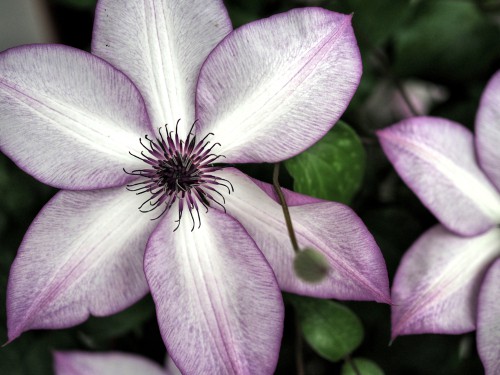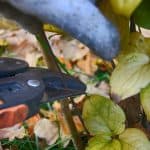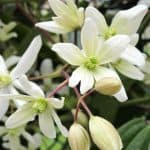Last updated on March 24th, 2023
Our site is reader supported, this means we may earn a small commission from Amazon and other affiliates when you buy through links on our site.
Much the same way as your body requires certain minerals and vitamins to survive, so does your clematis. In order to grow well and produce beautiful flowers, they need specific nutrients but they also need to be applied at the correct time. In general, feeding should not be done after September because you don’t want to encourage new growth later in the year that can be damaged by frost. We also recommend that you stop feeding when they come into flower if you are feeding them every couple of weeks with a liquid feed such as tomato feed. Mulch in autumn with farm manure and compost to add nutrients to the soil, protect the base from frost, as well as help to retain moisture once spring arrives.
If you want to read about a more specific way of feeding clematis, our next section covers this in more detail.
When do you feed clematis?
The appropriate time to start feeding your clematis is when the leaf buds have started to produce some growth in early spring. You need to understand that your soil temperature will impact the ability to absorb nutrients for your plant so it won’t do you any good to feed your clematis until the soil temperature is higher than about 12 degrees centigrade. The root growth slows down and it sometimes even stops when the soil temperature drops below this number. Therefore, when the root growth has subsided and doesn’t absorb nutrients as effectively it will be a waste for you to add food to the soil if your clematis cannot actually absorb that food.
Applying a feed around the end of February to early March is usually about the right time. Clematis love food but they use fertilisers in different ways contingent upon the season.
My recommended clematis fertilisers

How you feed your clematis begins with the right plant food at the right time.
- In the spring, once the leaf buds have started to shoot, put a handful of bonemeal around the base of the plant, dig it in and then water it in.
- You can then feed every 2-3 weeks with a feed (such as a tomato feed) to encourage flowering but make sure you stop this as soon as they begin to flower.
- Finally in autumn, put a handful of sulphate of potash around the base, along with a good layer of farm manure and compost as a mulch.
- If you have a clematis planted where it is difficult to apply fertiliser around the base, simply push 3 or 4 slow release fertiliser tablets around the base of the plant instead.
With each of these fertilisers, you should apply as instructed on the box. You should continue alternating these fertilisers in the fashion mentioned above until the end of September. Don’t feed after September except for adding the sulphate of potash and mulch in autumn.
Why food is important
The basic material used in these components is that of a humus base, and when you add humus to the soil it naturally breaks up the otherwise compact soil and improves the structure there. Tangentially it increases water conservation because the plant is able to effectively hold water. This also brings with it five different strains of beneficial microbes, each of which improves your plant’s ability to absorb nutrients and improve its immunity to plant diseases.
The main ingredients found in these fertilisers include nitrogen, phosphorus and potassium. Nitrogen is responsible for stimulating stem and leaf growth while phosphorus improves root growth and the production of flowers, and then potassium comes in and increases the disease resistance and general sturdiness of the plant. Your clematis simply cannot survive without these elements because it will be unable to produce the things that it needs.
Your clematis requires nitrogen, phosphorus, potassium and humus, all of which are found in the right food. With this regime, you will enjoy a much more rewarding flower display.
Last update on 2025-07-08 / Affiliate links / Images from Amazon Product Advertising API





